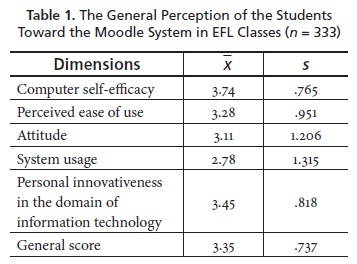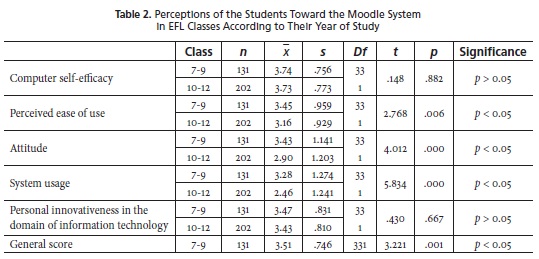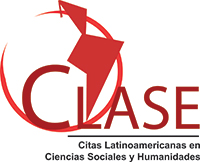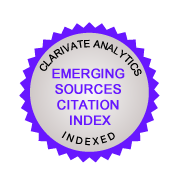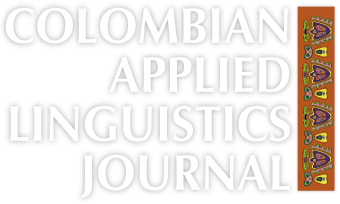Implementation of the Moodle System Into EFL Classes
Implementación del sistema Moodle en las clases de inglés como lengua extranjera
DOI:
https://doi.org/10.15446/profile.v19n_sup1.68571Keywords:
Learning management systems, Moodle, perception (en)percepción, plataforma Moodle, sistemas de administración de aprendizaje (es)
https://doi.org/10.15446/profile.v19n_sup1.68571
Implementation of the Moodle System Into EFL Classes
Implementación del sistema Moodle en las clases de inglés como lengua extranjera
Nuket Gunduz*
Deniz Ozcan**
Near East University, Mersin, Turkey
*nuket.gunduz@neu.edu.tr
**deniz.ozcan@neu.edu.tr
This article was received on September 1, 2017, and accepted on October 30, 2017.
How to cite this article (APA, 6th ed.):
Gunduz, N., & Ozcan, D. (2017). Implementation of the Moodle system into EFL classes. Profile: Issues in Teachers’ Professional Development, 19(Suppl. 1), 51-64. https://doi.org/10.15446/profile.v19n_sup1.68571.
This is an Open Access article distributed under the terms of the Creative Commons license Attribution-NonCommercial-NoDerivatives 4.0 International License. Consultation is possible at http://creativecommons.org/licenses/by-nc-nd/4.0/.
This study aims to examine students’ perception on using the Moodle system in secondary school in English as a foreign language lessons. A mixed method approach was used in this study with qualitative and quantitative research models. The study group consisted of 333 students and 12 English language teachers. The quantitative data were collected by a survey and qualitative data were collected by five open-ended questions. The results showed that students in general perceive themselves as sufficient in terms of the Moodle system and teachers thought that the system was contemporary and beneficial in the long run but at the time of the study it was not functioning well.
Key words: Learning management systems, Moodle, perception.
Este estudio busca explorar las percepciones de estudiantes sobre el uso de la plataforma Moodle en una clase de inglés como lengua extranjera. Se recurrió a un enfoque mixto que combinó los modelos cualitativo y cuantitativo. El grupo de estudio estuvo compuesto por 333 estudiantes y 12 profesores de inglés. Los datos cuantitativos se recogieron con una encuesta y los cualitativos con cinco preguntas abiertas. Los resultados muestran que, en general, los estudiantes se sienten cómodos con el uso de la plataforma Moodle y los docentes piensan que la plataforma es contemporánea y ofrece beneficios a largo plazo, aunque al momento de realizar el estudio la plataforma no estaba funcionando bien.
Palabras clave: percepción, plataforma Moodle, sistemas de administración de aprendizaje.
Introduction
The latest education developments in the world have made traditional notions of education out-dated and have given way to new, more innovative trends in teaching. These trends have been designed to meet student expectations and also to back up evolving pedagogical approaches (Ali & Jaafar, 2010; García Laborda & Litzler, 2011; García Laborda & Navarro Lavoulais, 2008; Vanova & Kazelleova, 2012; Yaman, 2010). Thus, more learner-centred approaches were sought in teaching any subject, including languages. Blended learning, which is an approach that can combine face-to-face teaching with e-learning programs like Moodle, has emerged to facilitate student-centred learning. This has in turn led to face-to-face classroom teaching to be supplemented by technologically driven educational environments, which are more learner-centred, more collaborative, and more innovative. Some studies pinpoint that language learners appreciate blended learning programs due to flexibility and autonomy (Goertler, Bollen, & Gaff, 2012; Larsen, 2012).
Contemporary technologies, especially the internet, have given a chance to teachers to use many interesting tools to improve the quality of the teaching-learning process. Usefulness of these tools makes it important for teachers to have more information about the advantages and possibilities of using technology in the classroom (Kaminski, 2005). Many studies have been conducted on this issue and some studies revealed that learners’ attitudes towards the internet may be influential in their engagement in internet-based learning tasks (Coffin & MacIntyre, 1999; Tsai, 2004). New technologies advancing each day have attracted education societies in using these tools for knowledge acquisition. There are various learning management systems (LMS) available in the market and Modular Object Oriented Dynamic Learning Environment (Moodle) is a free and open source e-learning software platform. Hence, in the relevant literature some studies refer to this system as Course management system (CMS), or virtual learning environment (VLE). However, Moodle will be referred to as LMS in this present study. These e-learning tools allow students to continue learning outside the school environment. Hence, a teacher is still necessary to facilitate the planning and preparation processes. Moodle is one of the preferred types as a method of learning based on electronic media which is designed using sound pedagogical principles, helping educators create effective online learning communities (Cuadrado-García & Ruiz-Molina, 2009).
Moodle helps educators to blend traditional classroom pedagogies with various web-based technologies in a single application (Lamb, 2004). Moodle is acknowledged as a self-directed, out of classroom practice which fosters learner autonomy. As indicated by Lamb (2004), learners generally welcome internet applications as they can learn at their own pace. Moreover, the Moodle environment aims to enhance students’ experience in learning and is designed with a constructivist pedagogical framework. From all the above mentioned factors, the major factor that has a role for Moodle to be preferred as a method of learning is that teachers can easily access this software on the program’s web page and design a page for their own course free of charge.
New learning approaches are aiming to enhance and extend learning opportunities for our twenty-first century learners. The rapid change and developments of the technologies have provided new possibilities for designing different kind of courses for language teaching and learning. Web-based courses are one type of these designs where they can stand alone for teaching/learning or be combined into the current education process. Moreover, when computers entered the education environments, e-learning came on the scene, offering educational web sites for learning scenarios, the creation of worksheets, interactive exercises, and many other tools for the learners. This trend was and still is approved for giving an advantage to learners to learn at their own pace as well as shifting power from teacher to student for acquiring knowledge, an opportunity that a classroom may not always offer (Barr & Tagg, 1995).
Language courses which combine face-to-face classroom teaching with the appropriate use of technology are a way to practice the blended learning approach. Sharma and Barret (2007), argue that the implementation of such technologies and their practices needs to be planned in a way that they can serve as an integral part of the teaching and learning process and not in isolation from the rest of the learning. Therefore, for the sake of integration, pre- and post-implementation stages of such systems are in need in order to consider the challenges and opportunities the language teachers and learners are likely to face. This study focuses on the students’ perceptions and the teachers’ opinions on the Moodle system, which was implemented as a supplement to face-to-face teaching to practise the blended learning approach in English College, a high school in North Cyprus.
Leaders of tomorrow are the students of today; considering the changes and demands of this age, there is a need to change and re-structure the educational environments to fulfil the requirements of future leaders. New technologies in the classrooms are a way for teachers to alter and change ways of instruction to meet the ever-changing needs of their students. Moodle has a significant international user base; English College has identified the need to extend the learning environment outside the physical location and hours of operation for the long-term success of the students and has implemented the Moodle system into their education process. English College’s objective with a grant from The European Commission for Schools’ Initiative for Innovation and Change was to facilitate student-centred learning by setting up the necessary hardware and software to strengthen the current networking infrastructure and train teachers and other staff (F. Tokay, personal communication, September 29, 2016). More specifically, the aim was to develop and deliver innovative, student-centred teaching methodologies. Even though the target group of this project initially was English College’s students, teachers, and school management, it is believed it will pave the way for other schools in developing countries.
Aim of the Study
The aim of the study was to examine the students’ perception on using the Moodle system in English College in English language lessons. More specifically, the study seeks to examine and explore students’ and English as a Foreign Language (EFL) teachers’ opinions on using the Moodle in their English classes.
- What is the general perception of the students toward the Moodle system in EFL classes?
- Are there any differences between perception of the students toward the Moodle system in EFL classes according to their
- Age?
- Gender?
- Year of study?
- System access?
- What are the teachers’ opinions regarding using Moodle in English lessons?
Research Design
The present study was undertaken to address students’ perceptions and teachers’ opinions of the Moodle system in English classes in English College in North Cyprus where it is currently being used as part of instruction. The study was designed using a mixed methods approach where quantitative data collection methods were used for collecting and analysing data about students’ perceptions and qualitative data collection methods used to collect data about teacher opinions on various aspects of the system.
Participants
The participants of the research consisted of 333 secondary school students studying in English College. Randomly selected students were categorized into two age groups where 131 (39%) of the students were in the age group of 13-15 (middle school level) and 202 (61%) were in the 16-18 (high school level) age group. Year six students were excluded from the survey because the academic year in which the study was carried out comprised their first experience with the Moodle system. Therefore, they did not have the necessary knowledge and experience to respond to the items in the questionnaire.
In addition to the student survey, 10 randomly selected English language teachers who were teaching in English College at the time of the study were asked to participate in the focus group discussions. Each group was accompanied by their department chiefs and there were 12 teachers who participated in the discussions. Focus group one consisted of six secondary school teachers and the second group of six teachers teaching in high school sections. The focus groups were balanced with six English teachers who were interviewed for the collection of qualitative data of teacher opinions about the Moodle system. Survey discussion questions attempted to collect data of responses giving insights about teachers’ opinions. Two focus group members consisted of eight female and four male teachers while six of them were teaching in the secondary level and the other six teaching in the high school level. Five teachers were in the age group 31-38, six were in 39-46, and only one in 47-54. Although each teacher had different years of teaching experience they all had been teaching over ten years. Five of the teachers had been teaching between 10 and 14, six teachers between 15 and 19, and one between 22 and 24. Teacher participants were all Turkish Cypriots and English language was not their native language.
Data Collecting Tools
For the first part of the study, which consisted of collecting data about the perceptions of students of the Moodle system, a researcher-made questionnaire adapted from “Learning Management Systems Coherence with Technology” was used. The questionnaire consisted of two parts. The first part was developed by the researcher to consist of five items for collecting information about students’ age, gender, class, and problems about accessing Moodle at home. The second part of the questionnaire contained 23 items, which were grouped under five dimensions for the analysis purpose. These dimensions were (a) self-efficacy (.965), (b) perceived ease of use (.890), (c) attitude (.972), (d) system usage (.911), and (e) personal innovativeness in the domain of information technology (.832). The items for the five dimensions were measured on a five level Likert scale ranging from 1 (strongly disagree) to 5 (strongly agree).
The second part of the questionnaire, where students’ perceptions were measured, was adapted from similar studies (Arteaga Sánchez & Duarte Hueros, 2010; van Raaij & Schepers, 2008). The questionnaire by Arteaga Sánchez and Duarte Hueros (2010) was adopted and structured with 28 items grouped under six dimensions: (a) technical support, (b) perceived usefulness, (c) computer self-efficacy, (d) perceived ease of use, (e) attitude, and (f) system usage. The questionnaire of van Raaij and Schepers (2008) consisted of 21 items grouped under six dimensions: (a) computer anxiety, (b) personal innovativeness in the domain of information technology, (c) perceived ease of use, (d) perceived usefulness, (e) subjective norm, and (f) intensity to use. The questionnaire of this research was restructured by eliminating the first dimension (technical support) in van Raaij and Schepers’ questionnaire because it was not valid for this study. Moreover, items about academic performance, effectiveness, and learning in university were eliminated from the “perceived usefulness” dimension that resulted in not being relevant in the reliability test. Furthermore, the first item of “perceived ease of use” (Learning is easy for me) was eliminated and the remaining items of perceived usefulness and perceived ease of use were grouped under (b) perceived ease of use and a new item (Item 7) was added (using Moodle increases my creativity). This item was added as creativity was considered to be a factor affecting achievement and also influencing innovation. The “personal innovativeness in the domain of informational technology” dimension was adopted from van Raaij and Schepers (2008) because it was considered to be important for the use of the Moodle system. It was considered that this variable could indicate the participants’ openness about experimenting new technologies. The original questionnaire was developed with seven-Likert scale and it was modified to five-Likert scale for this specific study. The reason for the reduction of the scales was due to the participants of this study being younger than the participants of the two studies that the questionnaires were adopted from.
The adopted questionnaire was structured in English and then translated into Turkish. These questionnaires were translated according to Hancer’s (2003) model of the serial approach which consists of six steps. In the first step, the questionnaire was translated by a committee of five lecturers working in the field of English language. Each member translated and edited the questionnaire individually. Then, for the second step, the questionnaire was given to four different individuals whose ages ranged from 13-16 years of age and these people were asked to evaluate the questionnaire for clarity of meaning and ease of understanding. Furthermore, the questionnaire was approved by academics in the English and Turkish language fields. Third, in order to identify and omit the problematic words, the questionnaire was translated back into English, that is, another translation. Fourth, the rephrased questionnaire was again given to a group of young people (n = 30) to carry out the field test. In order to measure the reliability (fifth step), in this part the results indicated that one dimension (perceived usefulness) had to be eliminated as mentioned in the materials part and some items of this dimension combined with another dimension (perceived ease of use); again, the questionnaire was given to 30 students for the second pilot survey and this time the Cronbach alfa was measured at .950. Finally, the questionnaire was evaluated and edited for the final time before application. In the end, the questionnaire used in this study consisted of 23 items, focusing on different dimensions of students’ perceptions.
For reliability and internal consistency, the researchers calculated the Cronbach alpha of the questionnaire for each dimension identified earlier. The results were .965 for first dimension (self-efficacy), .890 for the second dimension (perceived ease of use), .972 for the third dimension (attitude), .911 for the fourth dimension (system usage), and finally, .832 for the last dimension (personal innovativeness in the domain of information technology). The questionnaire used for data collection was therefore considered to be reliable. For content validity, the researcher used resources of previous studies about the Moodle system and the implementation of such systems into the education processes.
Qualitative data were also collected from two focus groups formed by English teachers. Five open-ended questions were prepared to be used in semi-structured discussions. These questions were:
- What are the benefits of using Moodle in your English courses?
- In what sense has Moodle made your students successful?
- What are the needed requirements for a teacher who is using Moodle to teach English?
- Do you believe that school facilities are adequate for the Moodle system to function?
- What are the attitudes of the students about the implementation of the Moodle system?
As the focus groups were designed to place the participants’ views on the table, additional questions were also directed to clarify responses and gather richer data during the discussions. The two focus groups were recorded, using a mobile phone and then each was transcribed for analysis.
Data Analysis
The quantitative analysis was conducted by using spss 22.0 and qualitative analysis was content based. While analysing the quantitative data collected through the questionnaires, descriptive statistics were used to find out the percentages and frequencies of the demographic features of the students. The variables of the perception on Moodle were explained with the lowest and the highest scores of mean and standard deviations. Then, t-tests were carried out based on a comparison of different groups and variables such as different grade levels and private lesson attendance. In addition, one way ANOVA and LSD (Least Significant Degree) were conducted to analyse and compare the significant differences in perceptions within and between groups that had different degrees of problems in accessing the Moodle system.
Qualitative data were analysed using the open coding method. Responses from each participant were analysed in detail and in isolation from those of other participants. Sentences, phrases, and words were studied separately in line with relation to the topic and analysed according to their relevance. Through repeated comparisons, similar ideas were integrated until major themes were established for each study question. There were multiple passes in the analysis process of these responses and the key words were identified accordingly. Then, the key words were classified into broader categories that might be refined and challenged until the key words were then classified reasonably to provide insights for the study. The researcher and a colleague analysed, coded, and categorized the data for the reliability of coding. Moreover, another coder independently coded all the responses of the participants. Through this process, two sets of themes were generated for each question and the coders compared the responses. However, when discrepancies were taken into consideration and coders were not able to reach an agreement on the meaning, the theme was coded again.
Findings and Discussion
The General Perception of the Students Toward the Moodle System in EFL Classes
The data collected from the questionnaires on students’ perceptions of the Moodle system were analysed in five different dimensions: (a) computer self-efficacy, (b) perceived ease of use, (c) attitude, (d) system usage, and (e) personal innovativeness in the domain of information technology. Out of the 23 items, six were in the first dimension (Items 1-6), seven were in the second dimension (Items 7-13), four in the third dimension (Items 14-17), two in the fourth dimension (Items 18-19), and finally four in the fifth dimension (Items 20-23). Table 1 shows the results of the questionnaire based on these five dimensions.
According to Table 1, students believe that they are confident in using computers in general because the mean score of their responses to dimension one (computer self-efficacy) are x̄ = 3.74 (s = .765). Students’ also found the system easy to use as their mean score for dimension two (perceived ease of use) was x̄ = 3.28 (s = .951). As for dimension three (attitude), respondents’ attitudes towards the system are positive with the mean score of x̄ = 3.11 (s = 1.206). The mean score for students’ responses to dimension four (system usage) is x̄ = 2.78 (s = 1.315), showing that students’ frequency in using the system is moderate. The mean score for the participants’ responses for dimension five (personal innovativeness in the domain of information technology) is x̄ = 3.45 (s = .818), indicating that students are innovative.
Generally, the reluctance of students in using technological systems like Moodle can be considered to be their lack of technology skills, problems about the usage, attitudes, or students not being innovative. The findings in this study revealed that even though students were self- efficient with computers, found the system easy to use, had positive attitudes, and were also innovative, they did not use the system frequently for some reason. Therefore, it might be argued that the traditional teaching-learning concepts are kind of habitually formed and are embedded in teaching practices while the adaptation of new technologies needs some time to be truly functional.
Perceptions of the Students Toward the Moodle System in EFL Classes According to Their Ages
In the t-test for the comparison of mean scores of different age groups for different dimensions, there are statistically significant differences between the groups in three dimensions while there is no significant difference in two of the dimensions.
Students ranging in age from 13 to 15 have a mean score of x̄ = 3.78, (s = .739) in terms of computer self-efficacy while the mean score of students whose ages range from 16 to 18 is x̄ = 3.71 (s = .783). In terms of computer self-efficacy, the calculated t-scores did not indicate any significant differences (t = .745). Moreover, the 13 to 15 age group’s perceived ease of use mean score is = 3.52 (s = .929) and the score of students group from 16 to 18 is x̄ = 3.12 (s = .933), indicating that there is a significant difference (t = 3.815) between the two groups. Perceptions of the students of the 13 to 15 age group of the system are more positive than the students in the 16 to 18 age group. There is a significant difference in terms of attitude (t = 5.283), showing that younger students show more interest in the system. The mean score for students aged 13 to 15 is x̄ = 3.53 (S = 1.073), while the score of students aged 16 to 18 is x̄ = 2.84 (s = 1.212).
In terms of system usage, the mean scores of the 13 to 15-year-olds is x̄ = 3.31 (s = 1.248) and the mean score of the 16 to 18-year-olds is x̄ = 2.44 (s = 1.245). There is a significant difference (t = 6.221), indicating that students in the 13 to 15 age group use the system more frequently than the 16 to 18 age group. Furthermore, the mean score of personal innovativeness in the domain of information technology for students aged 13 to 15 is x̄ = 3.47 (s = .839) and the mean score for the same dimension for students in the 16 to 18 age group is x̄ = 3.43 (s = .806), which indicates that there is no significant difference (t = .390) and both groups are equally innovative.
Participants’ age variation in the present study seems to have affected their perceptions of the Moodle system in three aspects. Firstly, younger students (13-15) seem to find the system easier to use than the older students (16-18). Secondly, students in the 13 to 15 age group showed more positive attitudes than the 16 to 19 group. Thirdly, younger students used the system much more than the older ones. In contrast, both age groups were self-efficient in computer skills and seemed to be equally innovative; generally, this would be expected to affect their technology usage whereas this is seen as not valid for this study.
Perceptions of the Students Toward the Moodle System in EFL Classes According to Their Gender
The mean scores of male and female students in terms of computer self-efficacy are very close. The mean score for females is x̄ = 3.72 (s = .734) and for males it is x̄ = 3.76 (s = .800). Moreover, the mean scores of the two groups in terms of perceived ease of use do not show a big difference. Mean score for females is x̄ = 3.34 (s = .914) and males’ is x̄ = 3.21 (s = .987), which again show no statistically significant difference. Female students’ mean score in terms of attitude is x̄ = 3.16 (s = 1.182) and male students’ mean score is x̄ = 3.05 (s = 1.232), indicating no significant difference. However, in terms of personal innovativeness in the domain of information technology, the mean score of female students is x̄ = 3.35 (s = .710) while the mean score for males is x̄ = 3.55 (s = .912). This finding suggests that there is a statistically significant difference between the two groups (t = -2.164), indicating that male students are more innovative than female students in terms of technology.
Gender issues related to using technology have been debated in various academic studies and some of them revealed that there are some differences while others argue the opposite. In this study, the findings indicate that both female and male students are self-efficient in computer skills as well as both finding the system easy to use. Both genders have positive attitudes towards the system and they use the system nearly at the same level. However, the only difference that this study reveals in terms of gender is that male students seem to be more open to new technologies than females, as the findings of the study show that they are more innovative.
Perceptions of the Students’ Toward the Moodle System in EFL Classes According to Their Year of Study
T-tests for the comparison of mean scores of different grade levels for five dimensions are presented in Table 2.
T-tests analysis for the comparison of mean scores of students’ year of study towards the Moodle system reveals that for computer self-efficacy, the mean score of students in grades 7, 8, and 9 (secondary level) is x̄ = 3.74 (s = .756) and the mean score for students in classes 10, 11, and 12 (high school level) is x̄ = 3.73 (s = .773). There is statistically no significant difference in terms of computer self-efficacy.
In terms of perceived ease of use the mean scores of students in grades 7, 8, and 9 is x̄ = 3.45 (s = .756) and the mean score of grades 10, 11, and 12 is x̄ = 3.16 (s = .929). There is a significant difference (t = 2.768) for perceived ease of use, indicating that secondary school students find the system easier to use than the high school students.
Mean score of the attitude of students enrolled in grades 7, 8, and 9 is x̄ = 3.43 (s = 1.141) and the mean score of students in grades 10, 11, and 12 is x̄ = 2.90 (s = 1.203). There is a significant difference (t = 4.012) showing that secondary school students’ attitudes towards the Moodle system are more positive than the high school students’.
In terms of system usage, the mean score of students in grades 7, 8, and 9 is x̄ = 3.28 (s = 1.274) and students in 10, 11, and 12 have a mean score of x̄ = 2.46 (s = 1.241), representing a statistically significant difference (t = 5.834). This shows that secondary school students are using the system more frequently than the high school students.
Students’ mean score for personal innovativeness in the domain of information technology is x̄ = 3.47 (s = .831) for grades 7, 8, and 9 and for grades 10, 11, and 12 the mean score is x̄ = 3.43 (s = .810), indicating that there is statistically no significant difference between the two groups in this dimension.
Perceptions of the Students Toward the Moodle System in EFL Classes According to System Access
ANOVA analysis shows that there are statistically significant differences between students’ perceptions of computer self-efficacy (f = 4.336, p < 0.05), students’ ease of use (f = 6.085, p < 0.05), students’ attitudes (f = 3.228, p < 0.05), and students’ system usage (f = 2.708, p < 0.05), and general score of students’ perception towards the Moodle system (f = 5.188, p < 0.05) in terms of their Moodle system access. However, the only dimension that indicates no significant difference (f = .987, p > 0.05) is between students’ perception of personal innovativeness in the domain of information technology.
A least significant difference (LSD) test has been carried out to identify the differences within the groups. The results of the LSD test shows that there is a statistically significant difference between the students who “never”, “seldom”, and “sometimes” have Moodle access problems and those who “often” have Moodle access problems according to students’ computer self-efficacy perceptions. These findings can be interpreted as students’ access to the Moodle system outside of school and affects their perception of their self-efficacy while using the Moodle system. Results show that perceptions of the students “never” having problems scores are higher than the others. This can be explained as these students having the opportunity to practice on the Moodle system and experience the benefits of the system better than others even during out of school hours. Moreover, there is a statistically significant difference between the students “never” having Moodle access problems, students “seldom”, and “sometimes” having Moodle access problems in terms of the perceptions of ease of use. Students “never” having Moodle access problems seem to have higher scores with positive perceptions of the systems ease of use.
The perceptions of the students who “never” have Moodle access problems are more positive than those students who experience having different degrees of problems. Since these students can find more opportunities than the students who are having problems for accessing the system outside school, they naturally seem to find the Moodle system easy to use.
There is a significant difference between the students “never” having Moodle access problems, and the students “sometimes” having Moodle access problems in terms of students’ attitudes. There is also a statistically significant difference between the students “seldom” having Moodle access problems, and the students “sometimes” having Moodle access problems in terms of students’ attitudes.
Students who are not facing problems in accessing the Moodle system seem to have positive attitudes towards the Moodle system. Besides these, system usage findings reveal that there is a statistically significant difference between the students “never” having Moodle access problems and the students “sometimes” having Moodle access problems. The comparison of “never” and “seldom” shows that perceptions of the students “never” having Moodle access problems seem to have higher scores in terms of students’ system usage. There is also a statistically significant difference between the students “seldom” and “sometimes” having Moodle access problems, and the students “often” having Moodle access problems, as students “often” having Moodle access problems have higher scores in terms of ease of system usage. The system usage perceptions of the students “often” having Moodle access problems seem to be more positive than the others, a finding which is interesting because it would be expected that when students have problems accessing the system they wouldn’t be able to develop positive attitudes. Finally, there is no statistically significant difference between the findings of the students’ personal innovativeness in the domain of information technology in relation to their degrees of problems in accessing the systems.
Teachers’ Opinions Towards the Moodle System
The data on teachers’ perceptions and opinions about the Moodle system were collected through five guiding interview questions and as the discussion unfolded in the focus groups, further questions were added to facilitate the collection of rich data. The emerging themes from the analysis of the qualitative data were organized under four headings: (a) The Frequency of Use and the Reasons, (b) Type of Use, (c) System Structure, and (d) General Opinions About the System.
The Frequency of Use and the Reasons
The majority of the teachers mentioned that they did not use the system frequently because some students were still facing problems with the system, like password, administration, and access issues. Moreover, from two focus groups only three teachers seemed to feel confident in using the system as frequently as possible. “The system is perfectly helpful during the revision week as well as for presentations and practices”, quoted one of teachers. The other teachers’ responses indicated that the reason for ignoring the system was the lack of technological knowledge. One striking response came from a teacher who had been teaching English in English College for eleven years but had been in the profession for twenty years: “I forced myself to connect to Moodle with English courses and understand the philosophy of this system, but could not find any connection or reason to use it”. This teacher also stated: “If I do not use the board to write and have my students write down what I dictate to them, I do not believe they will learn”. Another teacher supported her colleague by adding: “Absolutely true, I have been teaching for the last twelve years and I know that academics support the new trends but these trends are theoretical not practical. I cannot teach without my marker and the board.” These teachers underlined that traditional teaching was the best way to teach and supported their views as quoted, especially pinpointing that they did not believe that the system was beneficial.
Type of Use
Despite the fact that the frequency of use was not high among this group of teachers who participated in the discussions, it was clear that teachers used the system for various reasons. The majority of teachers (n = 8) pointed out that they used the system for teaching grammar. One of the teachers commented that: “I know that this is traditional teaching but I always used the system for teaching grammar because I believed that this is more suitable for my students”. Two teachers responded they used the system for lecturing in the class, as projecting the prepared course material onto the whiteboard saved time for more practice. They also added that the material to be practised was uploaded before the course began and the students printed the material out and stuck it in their notebooks before the lesson, which again saved them quite a lot of valuable in-class teaching time. Another preferred type of use seemed to be uploading revision materials to the system for students to access, which most teachers (n = 10) said they used right before the exams.
In addition, the system was used for collecting assignments; a teacher stated: “students uploaded assignments and I gave feedback.” Five of the teachers said they used the system for this purpose. However, one teacher stated: “I announced the deadline for the assignments to be uploaded; it ended up as a big disaster [because] the system crushed”. Some teachers (n = 7) also stated that they gave up using the system for collecting assignments due to the same reason. Moreover, “Nobody taught us how to grade”, “I have no time for struggling with the marking”, “We lack the technological knowledge”, and “time consuming” were the statements of some teachers (n = 6) for not using the system. One teacher claimed that she was using the system for giving information about the International English Language Testing System (IELTS) examination which saved time for her other class work. Furthermore, teachers responded they used the system for mini quizzes, comprehension texts, presentations, and web sites like ESL Cafe and also for extra composition tasks. However, each teacher used one or two of these ways of using the system and there was no one teacher who used the system in more than two different ways. The analysis of the data for types of use revealed that teachers seemed to use various types of the available options in the Moodle system but their uses were limited to a certain degree.
System Structure
In addition, in terms of frequency and type of use, the majority (n = 9) of the teachers stated that the school’s internet provision was not reliable and the system crashed at some stages. Lack of confidence in the system and the internet seemed to affect teachers and de-motivate them considering that 10 of them stated they felt sorry for the effort they spent because at times they could not finalize their work. To illustrate; “Internet is a must”, “Internet let me down for several times”, and “I have to bring my 3G”, were some phrases from the discussions. Besides these, some teachers (n = 4) stated in the discussion that they could not access the system from home, which is an internal issue in relation to how the system works, and this inability hindered their work.
General Opinions About the System
In general, participants thought the system was contemporary and beneficial in the long run but at the time of the study it was not functioning well. Another common opinion of the teachers that emerged from the collected data was that teachers believed the system was more suitable for younger students (secondary level) than high school students as the secondary group had more time to devote for understanding and comprehending the system. The reason for this opinion was that the high school students were studying hard to sit for international exams like IELTS and the General Certificate of Secondary Education (GCSE). One teacher said: “System can be used for grades nine and ten for basic English”, and also added that “Students who are entering IELTS and GCSE exams have to work on past papers and sit for mock exams, no time and need for Moodle.”
Generally, it seemed that the teachers who disliked the system did not like it because they lacked the necessary knowledge and skills to carry out electronic feedback and grading. More enthusiastic teachers, however, seemed to find their own solutions for the non-reliable internet facilities of the school, such as 3G connections. Interestingly, one teacher commented on the piloting period of the system which might be an answer to dislikes of the system. The comment was that the pilot students suffered a lot during that stage and had low marks due to the grading method which lacked the traditional written feedbacks. He also added that those students rumoured about the system and had created barriers towards it. Finally, the general and common view of the collected data shows that teacher participants are not against the Moodle system but are in need of more knowledge, time to adopt, and feel the system needs to be more structured.
Discussion and Conclusion
Technology driven learning is argued to be one of the necessities for the digital born generation of this century. Regarding this issue, Moodle was implemented to serve the on-going practices in English College high school by providing a variety of supplemental tools to be used in English language learning. Some studies also have shown Moodle to be effective in foreign language education (Cuadrado-García & Ruiz-Molina, 2009; Ming & Bidmeshki, 2004; Su, 2006; Yates & Delgado, 2008). The culture in developing countries like North Cyprus is in need of shifting their education environments from mindless memorization to innovative student-centred teaching. Digital technology integration in teaching and learning environments empowers access without borders to a variety of subject and topic contents (Bakia, Shear, Toyama, & Lasseter, 2012), whereas formal education is seen to have rising expectations regarding the practices and nature of methodology (Griffin, McGaw, & Care, 2012; UNESCO, 2011; Voogt & Knezek, 2008). Regarding the students’ perceptions towards the Moodle system, the results of the present study showed that they were digitally literate and able to cope with newly implemented systems.
The results of the survey also indicated students’ low frequency in using the system. Taking into account this result, the lack of teachers’ technology skills might be an important issue to consider for the students’ low usage of the system. Some national education systems in the developed countries are seen to implement information and communications technologies (ICT) into teaching and learning over a period of 25 or more years (Tatnall & Davey, 2014). However, the important issue is that this implementation has neither been accepted for teaching or learning on a wide scale, nor has it brought about the variety of benefits expected from the investment (OECD, 2015).
The results also indicated that the younger the students, the higher the positive perceptions towards the Moodle system. The school survey indicated that seventh grade especially was very enthusiastic and had the highest degree of using and benefiting from the system. Class distribution results also supported the results of the age variable, pinpointing that the secondary grades as years eight and nine had more positive attitudes and were using the system more than the high school participants. Many young people use digital devices, applications, and social networking sites on a daily basis (Greenhow & Lewin, 2016).
Teachers’ lack of the necessary knowledge and skills in using the Moodle system was also seen in the results; teachers need to develop new skills and knowledge of technologies (Duncan-Howell, 2010). The mismatch of the students’ and teachers’ digital literacy levels caused the teachers to prepare similar sets of exercises, as practised in the classroom, on a computer to deliver to students via Moodle. Similarly, Snyder (2009) argues that teachers are in need to rethink their pedagogies and move beyond using technology as a “fancy typewriter” and a presentation tool. Discussion remarks reveal that some enthusiastic teachers are trying hard to find ways to use the system like assignment delivery and extra links to support students’ learning but none of them seems to use all the facilities that are available in the Moodle system. Some researchers argue about this issue even though professional seminars or conferences are being delivered by experts (Duncan-Howell, 2010). The effect of long-lasting pedagogy, continuity, and coherence is considered insufficient (Anderson & Henderson, 2004; Curwood, 2011).
Teachers’ results pinpointed that some of the facilities that could make students more autonomous and successful in using the language were not utilized. Facilities as the asynchronous “chat” sessions and on-line quizzes with instant feedbacks were not practised at the time of this research. However, the good will of some enthusiastic teachers’ and younger students’ positive attitudes towards the system have shown that they seem to be empowered to be autonomous in using the language.
Recommendations
The general conclusion of the research reveals that the perceptions of English College students towards the Moodle system in EFL classes are rather positive. However, the need of the system’s structure to be upgraded and the teachers’ knowledge and skills in using the system to be improved emerged as the most important areas to be attended. The system’s structure of the implemented Moodle system in English College needs to be more structured and the internet access to be more reliable. Teachers’ awareness of the functions provided by Moodle and its possible areas for use should be raised with the help of training sessions. In addition to improvements in the teachers’ use of Moodle, students’ strengths in using the technical tools should be utilized in using the Moodle’s functions to help students become more autonomous in language learning. The role of the teacher and the role of technology should be balanced in a way that students will benefit from both at the highest degree.
References
Ali, M. N., & Jaafar, M. J. (2010). Transforming Moodle as a reflective tool in learning French language. International Journal of Academic Research, 2(3), 238-240.
Anderson, N., & Henderson, M. (2004). E-PD: Blended models of sustaining teacher professional development in digital literacies. E-learning, 1(3), 383-394. https://doi.org/10.2304/elea.2004.1.3.4.
Arteaga Sánchez, R., & Duarte Hueros, A. (2010). Motivational factors that influence the acceptance of Moodle using TAM. Computers in Human Behavior, 26(6), 1632-1640. https://doi.org/10.1016/j.chb.2010.06.011.
Bakia, M., Shear, L., Toyama, Y., & Lasseter, A. (2012). Understanding the implications of online learning for educational productivity. Washington, DC: U.S. Department of Education Office of Educational Technology.
Barr, R. B., & Tagg, J. (1995). From teaching to learning: A new paradigm for undergraduate education. Change: The Magazine of Higher Learning, 27(6), 12-26. https://doi.org/10.1080/00091383.1995.10544672.
Coffin, R. J., & MacIntyre, P. D. (1999). Motivational influences on computer-related affective states. Computers in Human Behavior, 15(5), 549-569. https://doi.org/10.1016/S0747-5632(99)00036-9.
Cuadrado-García, M., & Ruiz-Molina, M. E. (2009). The use of Moodle in higher education for improving English skills in non-language courses. Paper presented at the 2nd edition of the International Conference: ICT for LanguageLearning. Retrieved from https://conference.pixel-online.net/ICT4LL2009/common/download/Abstract_pdf/pdf/ILT12_Cuadrado-Garcia,Ruiz-Molina.pdf.
Curwood, J. S. (2011). Teachers as learners: What makes technology-focused professional development effective? English in Australia, 46(3), 68-75.
Duncan-Howell, J. (2010). Teachers making connections: Online communities as a source of professional learning. British Journal of Educational Technology, 41(2), 324-340. https://doi.org/10.1111/j.1467-8535.2009.00953.x.
García Laborda, J., & Litzler, M. F. (2011, June). Review of the book Teaching English language learners through technology, by T. Erben, R. Ban, & M. Castañeda. Language Learning & Technology, 15(2), 39-41.
García Laborda, J., & Navarro Laboulais, C. (2008). Automatizar los exámenes del diploma de español como lengua extranjera (DELE): utopía o realidad? [Automatizing the diploma of Spanish as foreign language tests (DELE): Utopia or reality?] RLA, Revista de Lingüística Teórica y Aplicada, 46(2), 81-93.
Goertler, S., Bollen, M., & Gaff, J. (2012). Students’ readiness for and attitudes toward hybrid foreign language instruction. CALICOJournal, 29(2), 297-320. https://doi.org/10.11139/cj.29.2.297-320.
Greenhow, C., & Lewin, C. (2016). Social media and education: Reconceptualizing the boundaries of formal and informal learning. Learning, Media and Technology, 41(1), 6-30. https://doi.org/10.1080/17439884.2015.1064954.
Griffin, P., McGaw, B., & Care, E. (Eds.). (2012). Assessment and teaching of 21st century skills: Methods and approach. Dordrecht, NL: Springer. https://doi.org/10.1007/978-94-007-2324-5.
Hancer, M. (2003). An investigation of different approaches in the translation of measurement scales. Balikesir University Journal of Institute of Social Sciences, 7(10), 47-60.
Kaminski, J. (2005). Editorial: Moodle - A user-friendly, open source course management system. Online Journal of Nursing Informatics (OJNI), 9(1).
Lamb, T. (2004). Learning independently? Pedagogical and methodological implications of new learning environments. Proceedings of the Independent Learning Conference 2003. Retrieved from https://www.independentlearning.org/ila03_lamb.pdf.
Larsen, L. (2012). Teacher and student perspectives on a blended learning intensive English program writing course (Doctoral dissertation). Iowa State University, Ames, USA.
Ming, T. S., & Bidmeshki, L. (2004). An online English course for Malaysian science and technology undergraduates: Evaluating learners’ responses, current perspectives and future directions in foreign language teaching and learning. Proceedings of CLaSIC 2004.
OECD. (2015). Students, computers, and learning: Making the connection. Paris, FR: OECD Publishing. https://doi.org/10.1787/9789264239555-en.
Sharma, P., & Barret, B. (2007). Blended learning: Using technology in and beyond the language classroom. Oxford, UK: Macmillan.
Snyder, I. (2009). Shuffling towards the future: The enduring dominance of book culture in literacy education. In M. Baynham & M. Prinsloo (Eds.), The future of literacy studies (pp. 141-159). New York, US: Palgrave Macmillan. https://doi.org/10.1057/9780230245693_8.
Su, C.-C. (2006). Moodle for English teachers. Proceedings of the 2006 International Conference and Workshop on TEFL & Applied Linguistics, Min Chuan University, 321-330.
Tatnall, A., & Davey, B. (Eds.). (2014). Reflections on the history of computers in education: Early use of computers and teaching about computing in schools. Heidelberg, DE: Springer. https://doi.org/10.1007/978-3-642-55119-2.
Tsai, C.-C. (2004). Adolescents’ perceptions toward the Internet: A 4-t framework. Cyber Psychology and Behavior, 7(4), 458-463. https://doi.org/10.1089/cpb.2004.7.458.
UNESCO. (2011). UNESCO ICT competency framework for teachers. Retrieved from http://iite.unesco.org/pics/publications/en/files/3214694.pdf.
van Raaij, E. M., & Schepers, J. J. L. (2008). The acceptance and use of a virtual learning environment in China. Computers & Education, 50(3), 838-852. https://doi.org/10.1016/j.compedu.2006.09.001.
Vanova, T., & Kazelleova, J. (2012). Using Moodle in the CLIL INTO SCHOOLS project. Paper presented at the 5th edition of the International Conference: ICT for LanguageLearning. Retrieved from https://conference.pixel-online.net/ICT4LL2012/common/download/Paper_pdf/132-CLI01-FP-Vanova-ICT2012.pdf.
Voogt, J., & Knezek, G. (Eds.). (2008). International handbook of information technology in primary and secondary education. New York, US: Springer. https://doi.org/10.1007/978-0-387-73315-9.
Yaman, S. (2010). Technology supported learning platform: Moodle integrated academic course. Turkish Online Journal of Distance Education, 11(2), 146-160.
Yates, N., & Delgado, R. (2008). A study concerning the use of Moodle at Kanda University of International Studies. The Journal of Kanda University of International Studies, 20, 405-426.
About the Authors
Nuket Gunduz holds both a Master’s and an undergraduate English language teaching degree from the Near East University, Turkey. She is currently pursuing a PhD degree at the same university.
Deniz Ozcan holds a PhD degree in curriculum and teaching from the Near East University, Turkey. She serves as an associate professor in the Department of Special Education at the same university.
References
Ali, M. N., & Jaafar, M. J. (2010). Transforming Moodle as a reflective tool in learning French language. International Journal of Academic Research, 2(3), 238-240.
Anderson, N., & Henderson, M. (2004). E-PD: Blended models of sustaining teacher professional development in digital literacies. E-learning, 1(3), 383-394. https://doi.org/10.2304/elea.2004.1.3.4.
Arteaga Sánchez, R., & Duarte Hueros, A. (2010). Motivational factors that influence the acceptance of Moodle using TAM. Computers in Human Behavior, 26(6), 1632-1640. https://doi.org/10.1016/j.chb.2010.06.011.
Bakia, M., Shear, L., Toyama, Y., & Lasseter, A. (2012). Understanding the implications of online learning for educational productivity. Washington, DC: U.S. Department of Education Office of Educational Technology.
Barr, R. B., & Tagg, J. (1995). From teaching to learning: A new paradigm for undergraduate education. Change: The Magazine of Higher Learning, 27(6), 12-26. https://doi.org/10.1080/00091383.1995.10544672.
Coffin, R. J., & MacIntyre, P. D. (1999). Motivational influences on computer-related affective states. Computers in Human Behavior, 15(5), 549-569. https://doi.org/10.1016/S0747-5632(99)00036-9.
Cuadrado-García, M., & Ruiz-Molina, M. E. (2009). The use of Moodle in higher education for improving English skills in non-language courses. Paper presented at the 2nd edition of the International Conference: ICT for LanguageLearning. Retrieved from https://conference.pixel-online.net/ICT4LL2009/common/download/Abstract_pdf/pdf/ILT12_Cuadrado-Garcia,Ruiz-Molina.pdf.
Curwood, J. S. (2011). Teachers as learners: What makes technology-focused professional development effective? English in Australia, 46(3), 68-75.
Duncan-Howell, J. (2010). Teachers making connections: Online communities as a source of professional learning. British Journal of Educational Technology, 41(2), 324-340. https://doi.org/10.1111/j.1467-8535.2009.00953.x.
García Laborda, J., & Litzler, M. F. (2011, June). Review of the book Teaching English language learners through technology, by T. Erben, R. Ban, & M. Castañeda. Language Learning & Technology, 15(2), 39-41.
García Laborda, J., & Navarro Laboulais, C. (2008). Automatizar los exámenes del diploma de español como lengua extranjera (DELE): utopía o realidad? [Automatizing the diploma of Spanish as foreign language tests (DELE): Utopia or reality?] RLA, Revista de Lingüística Teórica y Aplicada, 46(2), 81-93.
Goertler, S., Bollen, M., & Gaff, J. (2012). Students’ readiness for and attitudes toward hybrid foreign language instruction. CALICOJournal, 29(2), 297-320. https://doi.org/10.11139/cj.29.2.297-320.
Greenhow, C., & Lewin, C. (2016). Social media and education: Reconceptualizing the boundaries of formal and informal learning. Learning, Media and Technology, 41(1), 6-30. https://doi.org/10.1080/17439884.2015.1064954.
Griffin, P., McGaw, B., & Care, E. (Eds.). (2012). Assessment and teaching of 21st century skills: Methods and approach. Dordrecht, NL: Springer. https://doi.org/10.1007/978-94-007-2324-5.
Hancer, M. (2003). An investigation of different approaches in the translation of measurement scales. Balikesir University Journal of Institute of Social Sciences, 7(10), 47-60.
Kaminski, J. (2005). Editorial: Moodle - A user-friendly, open source course management system. Online Journal of Nursing Informatics (OJNI), 9(1).
Lamb, T. (2004). Learning independently? Pedagogical and methodological implications of new learning environments. Proceedings of the Independent Learning Conference 2003. Retrieved from https://www.independentlearning.org/ila03_lamb.pdf.
Larsen, L. (2012). Teacher and student perspectives on a blended learning intensive English program writing course (Doctoral dissertation). Iowa State University, Ames, USA.
Ming, T. S., & Bidmeshki, L. (2004). An online English course for Malaysian science and technology undergraduates: Evaluating learners’ responses, current perspectives and future directions in foreign language teaching and learning. Proceedings of CLaSIC 2004.
OECD. (2015). Students, computers, and learning: Making the connection. Paris, FR: OECD Publishing. https://doi.org/10.1787/9789264239555-en.
Sharma, P., & Barret, B. (2007). Blended learning: Using technology in and beyond the language classroom. Oxford, UK: Macmillan.
Snyder, I. (2009). Shuffling towards the future: The enduring dominance of book culture in literacy education. In M. Baynham & M. Prinsloo (Eds.), The future of literacy studies (pp. 141-159). New York, US: Palgrave Macmillan. https://doi.org/10.1057/9780230245693_8.
Su, C.-C. (2006). Moodle for English teachers. Proceedings of the 2006 International Conference and Workshop on TEFL & Applied Linguistics, Min Chuan University, 321-330.
Tatnall, A., & Davey, B. (Eds.). (2014). Reflections on the history of computers in education: Early use of computers and teaching about computing in schools. Heidelberg, DE: Springer. https://doi.org/10.1007/978-3-642-55119-2.
Tsai, C.-C. (2004). Adolescents’ perceptions toward the Internet: A 4-t framework. Cyber Psychology and Behavior, 7(4), 458-463. https://doi.org/10.1089/cpb.2004.7.458.
UNESCO. (2011). UNESCO ICT competency framework for teachers. Retrieved from http://iite.unesco.org/pics/publications/en/files/3214694.pdf.
van Raaij, E. M., & Schepers, J. J. L. (2008). The acceptance and use of a virtual learning environment in China. Computers & Education, 50(3), 838-852. https://doi.org/10.1016/j.compedu.2006.09.001.
Vanova, T., & Kazelleova, J. (2012). Using Moodle in the CLIL INTO SCHOOLS project. Paper presented at the 5th edition of the International Conference: ICT for LanguageLearning. Retrieved from https://conference.pixel-online.net/ICT4LL2012/common/download/Paper_pdf/132-CLI01-FP-Vanova-ICT2012.pdf.
Voogt, J., & Knezek, G. (Eds.). (2008). International handbook of information technology in primary and secondary education. New York, US: Springer. https://doi.org/10.1007/978-0-387-73315-9.
Yaman, S. (2010). Technology supported learning platform: Moodle integrated academic course. Turkish Online Journal of Distance Education, 11(2), 146-160.
Yates, N., & Delgado, R. (2008). A study concerning the use of Moodle at Kanda University of International Studies. The Journal of Kanda University of International Studies, 20, 405-426.
How to Cite
APA
ACM
ACS
ABNT
Chicago
Harvard
IEEE
MLA
Turabian
Vancouver
Download Citation
CrossRef Cited-by
1. Julian Dario Silva-Perdomo, María Soledad Duero-Naranjo, Jairo Enrique Castañeda Trujillo. (2022). Experiences of English as Foreign Language student using ICT in their learning process. GIST – Education and Learning Research Journal, 24, p.141. https://doi.org/10.26817/16925777.1396.
2. Natalya Morgoun, Elena Kozharskaya, Margarita Kozhevnikova. (2021). Moodle-based Teaching of ESP Vocabulary: a Case Study. Proceedings of the 2021 12th International Conference on E-Education, E-Business, E-Management, and E-Learning. , p.75. https://doi.org/10.1145/3450148.3450203.
3. kodhandaraman chinnathambi, Salim Bani Orabah, Siti Sarah Rani, Latha Anandan. (2023). Omani Students’ Satisfaction with Independent Learning Tools during Covid-19. SSRN Electronic Journal, https://doi.org/10.2139/ssrn.4351344.
4. Nadiya Holiver, Tetiana Kurbatova, Iryna Bondar, S. Semerikov, S. Chukharev, S. Sakhno, A. Striuk, V. Osadchyi, V. Solovieva, T. Vakaliuk, P. Nechypurenko, O. Bondarenko, H. Danylchuk. (2020). Blended learning for sustainable education: Moodle-based English for Specific Purposes teaching at Kryvyi Rih National University. E3S Web of Conferences, 166, p.10006. https://doi.org/10.1051/e3sconf/202016610006.
5. Ilba Yaneth Rodríguez Tamayo, Leidy Jhoanna Vargas Hernández. (2020). Schoology: una herramienta para el desarrollo de la habilidad escrita en inglés. Colombian Applied Linguistics Journal, 22(1), p.13. https://doi.org/10.14483/22487085.14348.
6. Laurent Moccozet, Maya Böckh. (2023). Language Awareness and Identity. Multilingual Education. 45, p.45. https://doi.org/10.1007/978-3-031-37027-4_3.
7. Roghibatul Luthfiyyah, Gusti Nur Hafifah, Francisca Maria Ivone, Sintha Tresnadewi. (2021). Technology use in secondary level of English language teaching: A Literature Review. JEES (Journal of English Educators Society), 6(1), p.79. https://doi.org/10.21070/jees.v6i1.1020.
8. Nara Faiz Saskara Saskara, Pepen Permana, Irma Permatawati. (2025). Moodle in German Language Learning: Advantages and Disadvantages. Didaktika: Jurnal Kependidikan, 14(3), p.4859. https://doi.org/10.58230/27454312.2306.
9. Božena Horváthová. (2023). Philological study programs in the digital age: A comprehensive analysis of Moodle integration and utilization. Journal of Language and Cultural Education, 11(2), p.77. https://doi.org/10.2478/jolace-2023-0017.
Dimensions
PlumX
Article abstract page views
Downloads
License
Copyright (c) 2017 Profile: Issues in Teachers' Professional Development

This work is licensed under a Creative Commons Attribution-NonCommercial-NoDerivatives 4.0 International License.
You are authorized to copy and redistribute the material in any medium or format as long as you give appropriate credit to the authors of the articles and to Profile: Issues in Teachers' Professional Development as original source of publication. The use of the material for commercial purposes is not allowed. If you remix, transform, or build upon the material, you may not distribute the modified material.
Authors retain the intellectual property of their manuscripts with the following restriction: first publication is granted to Profile: Issues in Teachers' Professional Development.




